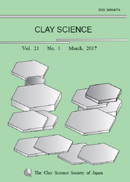
- Issue 3-4 Pages 33-
- Issue 1-2 Pages 1-
- |<
- <
- 1
- >
- >|
-
Shohei Yamaguchi, Yohei Ishida2025Volume 29Issue 3-4 Pages 33-38
Published: December 25, 2025
Released on J-STAGE: December 25, 2025
JOURNAL FREE ACCESSClay mineral nanosheets obtained by exfoliation are approximately 1 nm thick, two-dimensional materials bearing negative charges originating from isomorphic substitution. These nanosheets are widely used in constructing supramolecular complexes through electrostatic interactions. Although the formation of such complexes critically depends on the nanosheet’s surface charge distribution, its local variations remain poorly understood. In this study, we aimed to visualize the surface charge distribution of clay mineral nanosheets using annular dark-field scanning transmission electron microscopy (ADF-STEM). To this end, heavy alkali metal ions, Rb+ and Cs+, were introduced as elemental markers via ion exchange, and their distributions were visualized as bright spots in both monolayer and multilayer regions. The experimental observations closely matched image simulations, confirming that the bright spots correspond to the marker ions. However, under continuous electron beam irradiation—especially at an accelerating voltage of 300 kV—the markers exhibited noticeable mobility. These findings highlight the need for structural strategies to immobilize marker ions within the interlayer space or nanosheet framework to enable stable and reliable visualization of surface charge distributions.
View full abstractDownload PDF (5030K)
-
Ezz-Elregal M Ezz-Elregal, Makoto Oishi, Takuro Nagai, Yusuke Ide2025Volume 29Issue 3-4 Pages 39-45
Published: December 25, 2025
Released on J-STAGE: December 25, 2025
JOURNAL FREE ACCESSGreen rust (GR), a Fe2+/Fe3+-layered double hydroxide (LDH), was thought to be extremely unstable toward oxidation and thus less well studied as catalysts and their supports than many other LDHs. Here, the modification of a [Fe2+–Fe3+] mixed valent iron hydroxide, that we term GR, with Cu species and application of the Cu-modified GR as the catalyst for the hydrolysis of ammonia borane (AB) are described. From spectroscopic and microscopic analyses, the Cu-modified GR was composed of plate-like GR particles decorated with Cu2O clusters and nanoparticles on the particles’ surfaces and edges. The Cu-modified GR, synthesized via the modification of ball-milled GR with Cu2O species, exhibited an excellent H2 evolution rate and amount at room temperature under solar simulator irradiation that was faster and larger, respectively, than Pt nanoparticle-supported and Cu-modified TiO2. Control catalytic tests without solar simulator irradiation and an action spectrum study suggested that the Cu-modified GR showed light-assisted catalysis toward AB hydrolysis thanks to Cu2O modifiers.
View full abstractDownload PDF (3752K) -
Masanori Kohno, Shun Kondo, Tsuyoshi Nishimura2025Volume 29Issue 3-4 Pages 47-55
Published: December 25, 2025
Released on J-STAGE: December 25, 2025
JOURNAL FREE ACCESSPerformance of bentonite buffer materials used in the construction of geological repositories for high-level radioactive waste in coastal areas is significantly affected by salinity, thereby making it essential to evaluate these effects. This study aimed to investigate the effects of salinity on the swelling, outflow, and permeability characteristics of bentonite, a buffer material, in NaCl solutions at various concentrations. To this end, one-dimensional-swelling, radial-outflow, and backpressure loading-type falling-head-permeability experiments were conducted on a compacted bentonite specimen (Kunigel-V1; diameter: 50 mm; height: 10 mm; dry density: 1.5 Mg/m3) for 180 days. The experimental results show that as the salinity of the NaCl solution increased, the swelling pressure and outflow volume of bentonite decreased, while the hydraulic conductivity increased. Here, the salinity effects were analyzed based on (1) the interlayer swelling due to the hydration reaction of montmorillonite and (2) the swelling behavior associated with the diffuse electric double layer on the surface of montmorillonite particles. The observed trends in the experimental results are generally consistent with these mechanisms. Thus, this study serves as a guide for optimizing materials to enhance the safety of geological disposal systems. Our findings have policy implications and practical applications, as they help develop strategies to mitigate salinity effects in coastal and saline environments for radioactive waste containment.
View full abstractDownload PDF (1208K)
- |<
- <
- 1
- >
- >|